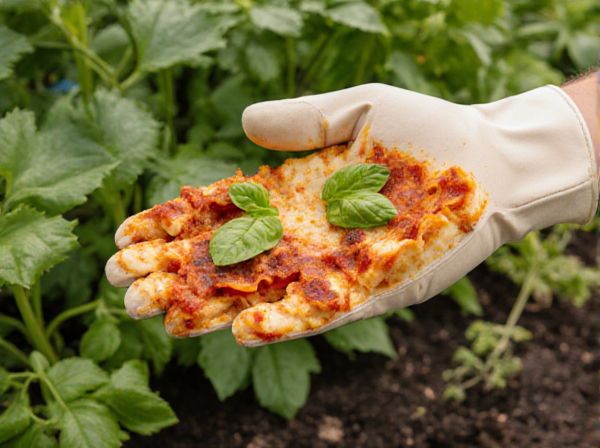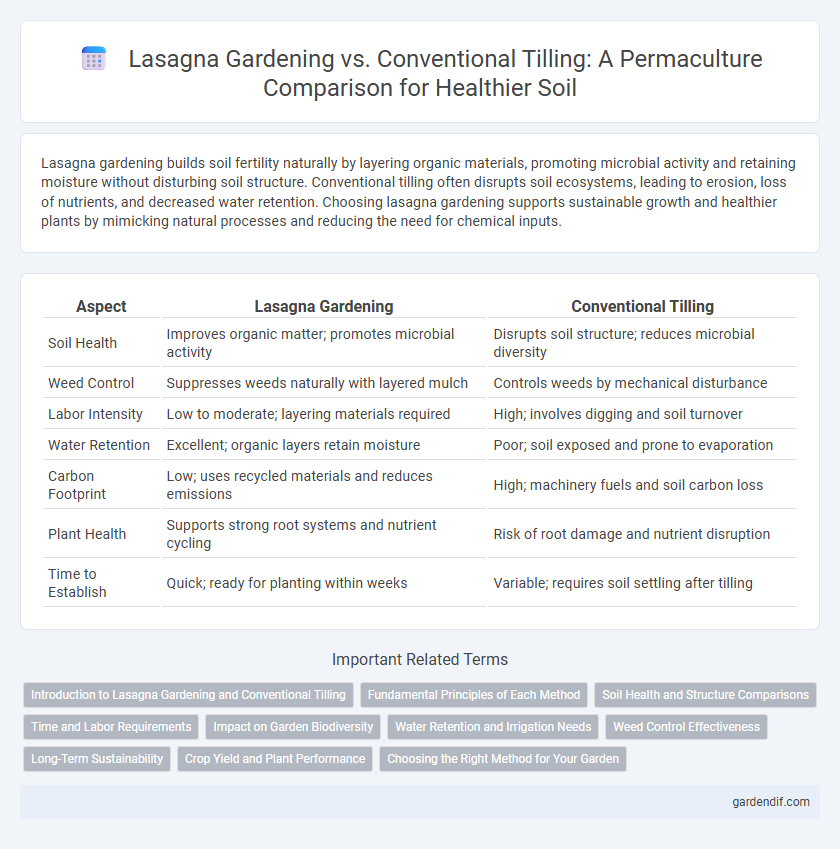
Lasagna Gardening vs Conventional Tilling Illustration
Lasagna gardening builds soil fertility naturally by layering organic materials, promoting microbial activity and retaining moisture without disturbing soil structure. Conventional tilling often disrupts soil ecosystems, leading to erosion, loss of nutrients, and decreased water retention. Choosing lasagna gardening supports sustainable growth and healthier plants by mimicking natural processes and reducing the need for chemical inputs.
Table of Comparison
| Aspect | Lasagna Gardening | Conventional Tilling |
|---|---|---|
| Soil Health | Improves organic matter; promotes microbial activity | Disrupts soil structure; reduces microbial diversity |
| Weed Control | Suppresses weeds naturally with layered mulch | Controls weeds by mechanical disturbance |
| Labor Intensity | Low to moderate; layering materials required | High; involves digging and soil turnover |
| Water Retention | Excellent; organic layers retain moisture | Poor; soil exposed and prone to evaporation |
| Carbon Footprint | Low; uses recycled materials and reduces emissions | High; machinery fuels and soil carbon loss |
| Plant Health | Supports strong root systems and nutrient cycling | Risk of root damage and nutrient disruption |
| Time to Establish | Quick; ready for planting within weeks | Variable; requires soil settling after tilling |
Introduction to Lasagna Gardening and Conventional Tilling
Lasagna gardening is a no-till, layering technique that builds fertile soil by decomposing organic materials such as leaves, kitchen scraps, and compost, enhancing soil structure and microbial activity. Conventional tilling disrupts soil ecosystems by mechanically turning the soil, which can lead to erosion, loss of organic matter, and decreased soil fertility over time. Lasagna gardening promotes long-term soil health through natural layering, while conventional tilling offers immediate soil aeration but may degrade soil quality with repeated use.
Fundamental Principles of Each Method
Lasagna gardening relies on layering organic materials such as compost, leaves, and grass clippings to create nutrient-rich, loose soil that promotes water retention and microbial activity. Conventional tilling involves mechanically turning the soil to aerate it and incorporate fertilizers, aiming for immediate crop readiness but often disrupting soil structure and beneficial organisms. The fundamental principle of lasagna gardening emphasizes building soil health through natural decomposition, whereas conventional tilling prioritizes quick soil preparation for planting.
Soil Health and Structure Comparisons
Lasagna gardening enhances soil health by layering organic materials that decompose into nutrient-rich humus, improving soil structure, moisture retention, and microbial activity without disturbing soil layers. Conventional tilling often disrupts soil aggregates and microbial communities, leading to increased erosion, nutrient loss, and compaction over time. Studies show that lasagna gardening promotes long-term soil fertility and biodiversity, contrasting with the degradation risks associated with frequent tillage.
Time and Labor Requirements
Lasagna gardening significantly reduces labor by eliminating the need for intensive tilling and soil preparation, using layered organic materials that naturally decompose to enrich the soil. Conventional tilling demands more time and physical effort, involving soil turning, weed removal, and disruption of soil structure, which can also increase erosion risk. Lasagna gardening promotes efficient use of time and energy while enhancing soil health and moisture retention.
Impact on Garden Biodiversity
Lasagna gardening enhances garden biodiversity by creating layered habitats that support diverse microorganisms, insects, and beneficial soil fauna. Conventional tilling disrupts soil structure, reduces microbial populations, and diminishes habitat complexity, leading to lower biodiversity levels. This method promotes healthier ecosystems by maintaining organic matter and fostering symbiotic relationships within the garden soil.
Water Retention and Irrigation Needs
Lasagna gardening enhances water retention by layering organic materials that improve soil structure and moisture-holding capacity, reducing the need for frequent irrigation. Conventional tilling disrupts soil aggregates, leading to faster water evaporation and increased irrigation demands. This method tends to deplete organic matter and impair soil's natural ability to conserve water compared to lasagna gardening.
Weed Control Effectiveness
Lasagna gardening offers superior weed control by using thick layers of organic mulch that smother weed seeds and prevent their germination, reducing the need for manual weeding. Conventional tilling often brings dormant weed seeds to the soil surface, triggering their growth and increasing weed pressure. The layered approach in lasagna gardening creates a dense, nutrient-rich environment that suppresses weeds more effectively than traditional tilling methods.
Long-Term Sustainability
Lasagna gardening enhances long-term soil fertility by layering organic materials that decompose naturally, promoting microbial activity and moisture retention without disturbing soil structure. Conventional tilling disrupts soil ecosystems, leading to erosion, nutrient loss, and reduced carbon sequestration over time. Prioritizing lasagna gardening supports sustainable permaculture practices by preserving soil health and fostering resilient plant growth.
Crop Yield and Plant Performance
Lasagna gardening enhances crop yield by improving soil structure and nutrient availability through layered organic materials, promoting robust plant growth and higher productivity compared to conventional tilling. Conventional tilling often disrupts soil ecosystems, leading to nutrient depletion and reduced microbial activity, which can negatively impact plant performance. Studies show that lasagna gardening supports sustained moisture retention and healthier root development, resulting in stronger, more resilient crops.
Choosing the Right Method for Your Garden
Lasagna gardening enhances soil fertility by layering organic materials, promoting moisture retention and reducing weed growth, ideal for sustainable and low-maintenance gardens. Conventional tilling, while effective for aerating soil and controlling pests, can lead to soil erosion and loss of beneficial microorganisms over time. Selecting the right method depends on garden goals, soil health, and environmental impact, favoring lasagna gardening for long-term soil vitality and conventional tilling for immediate soil preparation.
Lasagna Gardening vs Conventional Tilling Infographic

 gardendif.com
gardendif.com